A follow-up email is an email or sequence of emails sent in response to the actions of subscribers. It stimulates them to choose a paid plan instead of a free trial, set up a meeting for B2B, leave feedback, buy another product on an e-commerce website, etc.
Why are follow-up emails important?
- Increase conversion
- Build trust
- Filter the audience
- Automate email marketing
- Increase conversion. There are many reasons for recipients not to open an email. People are busy, or your email may be lost in an inbox among hundreds of other emails. A follow-up email is a way to add value and to assist your customers in every step of the buyer's journey.
- Build trust. With follow-up emails, you don’t send just one cold email hoping that people will take action, but you work hard to put your business in front of them. Follow-up emails show that you care and that your brand stands by a customer-centered approach. It’s a primary concern to make follow-up emails work for the sake of both customers and the brands that send them.
- Filter the audience. There is no way you will convert people who are indifferent from the beginning. Perhaps they’ve subscribed expecting to have something for free. Follow-up emails sift the engaged audience from the users that will never communicate with your brand.
- Automate email marketing. Sending follow-up emails is an automated process with SendPulse. You can once set up a sequence of follow-up emails to cover a particular scenario. After that, follow-up emails will be sent without your participation.
Types of Follow-up Emails
- Free trial follow-up
- Lead magnet opt-in follow-up
- Product Sale Follow-up
Free trial follow-up
Some SaaS companies offer free trials, letting potential customers test out the value of their software before buying the full version. The primary purpose of this type of follow-up email is to encourage customers to become a paid customer.
Free trial follow-up emails ask for feedback about a product and provide tips about how to use their product to achieve better results. And at last, this style of email offers a hint that a user will have more tools in their arsenal within a paid plan.
Lead magnet opt-in follow-up
People subscribe and provide their email addresses in exchange for a specific reward mentioned in a subscription form. For the second step of the double-opt-in, subscribers go to their email inbox to confirm the subscription.
In case something is interrupted in this process, and the potential client left half-way through the process, lead magnet opt-in follow-up reminds users to finish their subscription. Follow up emails show the value a recipient can gain after completing their subscription.
Product Sale Follow-up
An important goal in marketing is turning a one-time consumer into a loyal client. Product sale follow-up emails aim to add more value to the previous purchase.
After the sale happened, ask the customers about their experience using the item or service they bought from you, and suggest purchasing some additional products. In a follow-up email, you can propose discounts for products that enrich the original purchase.
When to Send a Follow-up Email
There is no particular time that is best for sending follow-up emails. If you send emails at 3 pm, many people from your audience are likely busy. So it would be a good idea to send the next follow-up email in the evening. If evening emails have a low open-rate, try sending an email in the morning.
Follow-up emails enable you to try different variants until you achieve the desired action from your subscribers. It doesn’t matter whether it’s a “yes” — an open, a click through, forwarding, or a ”no” — unsubscribing.
How to Write a Marketing Follow-up Email
The three main points that differentiate a follow-up email from any other email campaign are:
- It’s a set of emails sent with a particular frequency. A follow-up email is a sequence of emails. It is crucial not to send them too often to avoid irritating a user. At the same time, don't send them too seldom, or you may lose the users' attention. You need to determine the frequency that allows you to put your business in front of a customer but is not too intensive.
- It has the same incentive in different forms. Make the structure of every new follow-up email different from the previous one, but deliver the same idea and value. Describe the particular benefits in various forms.
- It should be brief. Unlike email newsletters, which are unlimited in length, follow-up emails should be concise and straightforward. It’s necessary to be transparent and honest, especially in B2B communication, where the main idea is to contact a decision-maker.
Now, when you know the types of follow-up emails and how to write them, it's high time you chose a marketing service to automate the process.
Let's skyrocket user engagement!
You can easily automate your workflow by setting triggers and conditions that will send personalized emails to your subscribers.
How to Create a Follow-up Email
- Create an automation flow
- Set up the start of the flow
- Create your first follow-up email
- Continue with the second follow-up
- Send another follow-up email later
Imagine that you run an online music shop, and your subscriber has purchased a guitar. You plan to cross-sell a new package of strings, a tuner, and a guitar amplifier. With SendPulse Automation360, you can create a sequence of follow-up emails to complete this task.
Step 1: Create an automation flow
Name the automation, choose the email sender address, and write the sender’s name. Next, choose the date and time that you want to send your email.
Step 2: Set up the start of the flow
Click on the element “Flow start” and set it up on the right-hand side. Select the event that will bring this automation to life (the trigger). Possible events include “Add Subscriber,” “Special date,” “Contact webhook,” “Change variable,” or any custom event that you create in the Event Manager.
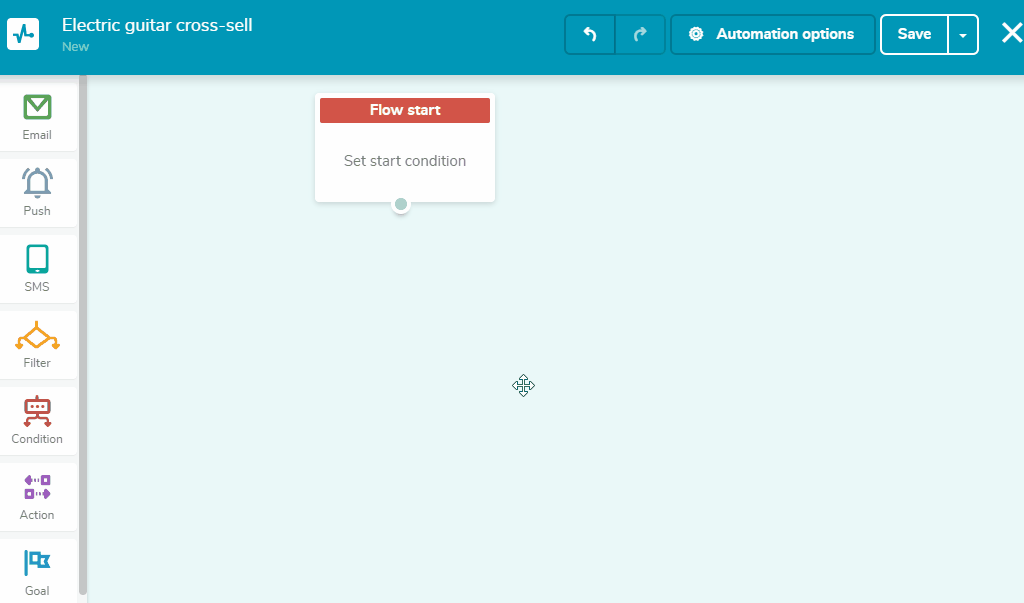
Step 3: Create your first follow-up email
Drag the “Email” element from the left-hand side and drop it under “Flow start.” Select the sending time — 5 days after the flow starts in this example, type in the subject line, and add an email template.
In this follow-up email, ask if everything is okay with the purchase and kindly suggest buying a package of strings with slightly different, more “garage” sound.
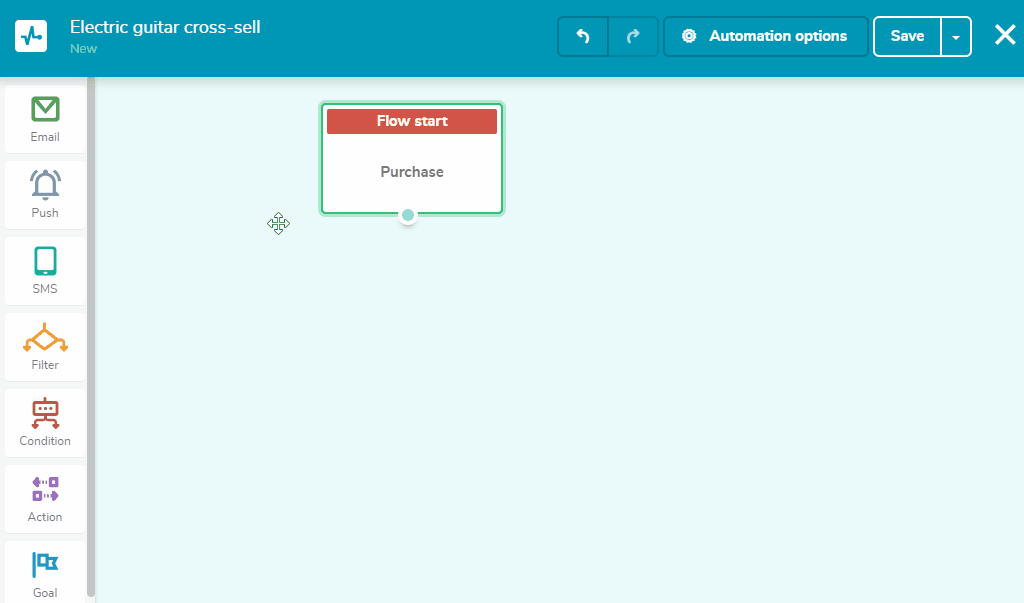
Step 4: Continue with the second follow-up
Add another “Email” element repeating actions from the previous step. Give recipients more time before sending the second follow-up.
Seven days after the previous email is a good time to suggest buying a tuner. Perhaps the customer is an amateur, or his tuner doesn’t work. It’s high time for your shop to cross-sell.
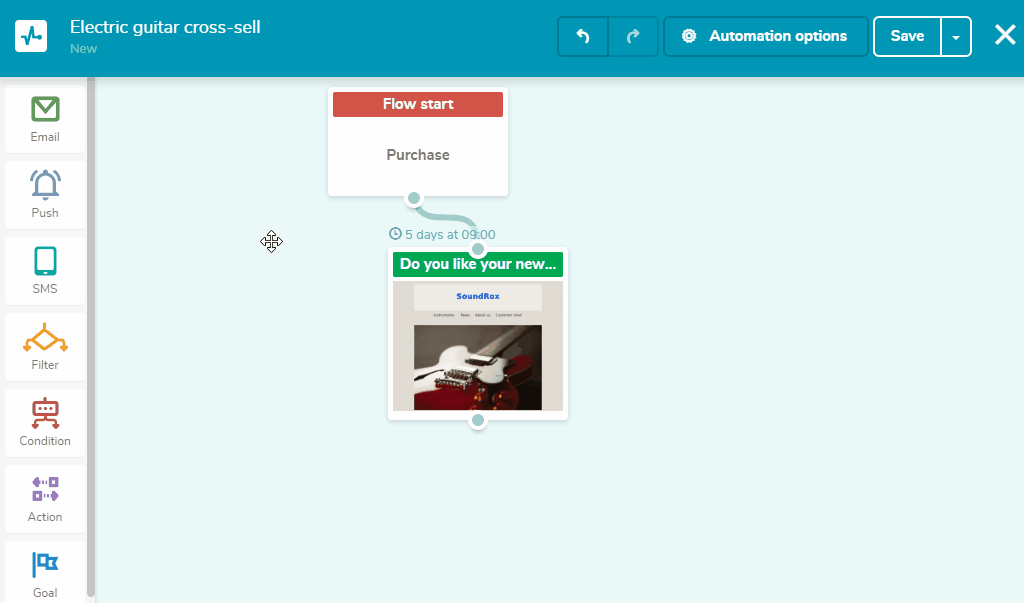
Step 5: Send another follow-up email later
Repeat the actions from the two previous steps.
Send this email about a month after the purchase. This time offer something huge, like a guitar amplifier, for instance.
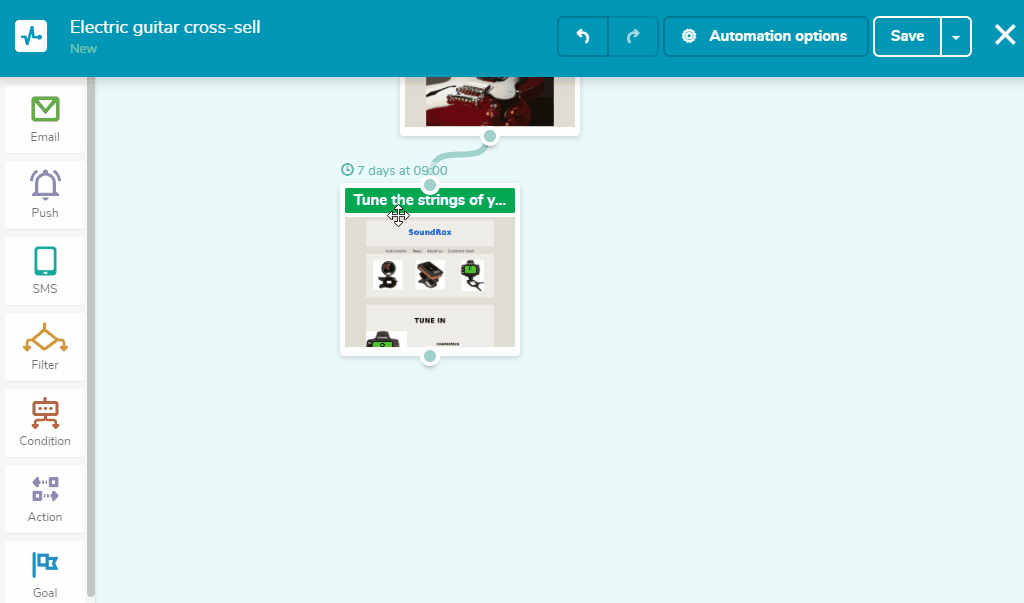
Follow-up email best practices
- Set up automation
- Use segmentation
- Create engaging subject lines
- Pick up the right frequency
- Request feedback
- Make your message brief
- Offer relevant products and services
- Take a customer-oriented approach
- Set up automation. It is hardly even possible to create follow-up emails manually. You need to make use of automation because it’s a huge source for improving the buyer experience. Automation will increase your potential revenue, as well, because it can send emails for you!
- Use segmentation. This email marketing tool allows you to make follow-up emails more personalized and relevant. You need to segment your mailing lists and use segments for creating the follow-up email sequence.
- Create engaging subject lines. The subject line is a critical factor when recipients are deciding whether to open a follow-up email or not. Make your subject lines relevant, and your recipients will understand what benefits are waiting for them in the email.
- Pick up the right frequency. The best rate is descending. Send every next follow-up email in the sequence within a more extended period. Otherwise, your email marketing will look too intensive.
- Request feedback. The first follow up email in the series should ask for feedback, ask customers if they like the product or service. Find out if there’s anything that you can do to help them. This is the right approach for building trust with your audience. After all, everyone likes to feel like someone cares about them.
- Make your message brief. A follow-up email is a flexible instrument for convincing someone to do something. It may look like an insignificant message, but the amount of value it provides is a good motivation for people to become more loyal and highly-engaged.
- Offer relevant products and services. Make sure that your proposals are something that people need. A follow-up email is not about forcing people to take action — it’s about bringing so much value that it’s hard to resist.
- Take a customer-oriented approach. Summing up the best practices above, the most authentic way to build mutually successful relationships with your audience is to make your customers and their needs the core element of your business.
Follow-up Email Examples
Netflix. Here is an example of a lead magnet opt-in follow-up. The lead magnet is a one-month free trial.
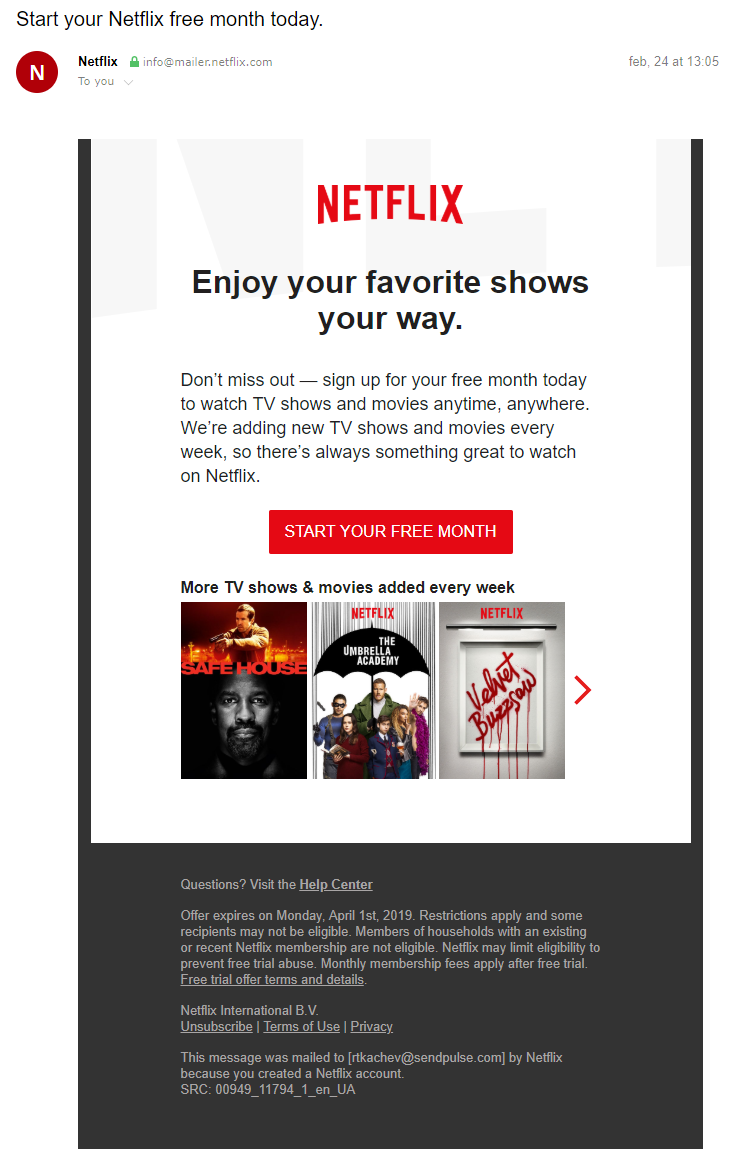
Grammarly. Very persuasive and well-performed free trial follow-up email. The value provided in these emails is massive.
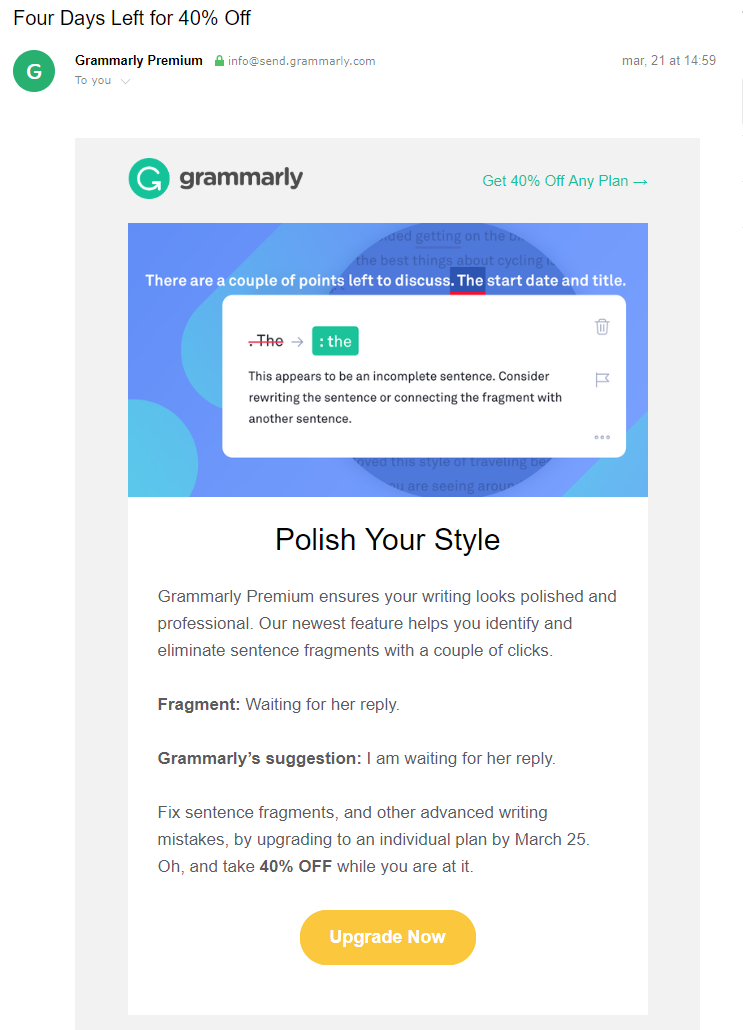
Wobbo. This follow-up email is a desperate cry! Little Wobbo asks the recipient to finish what they started.
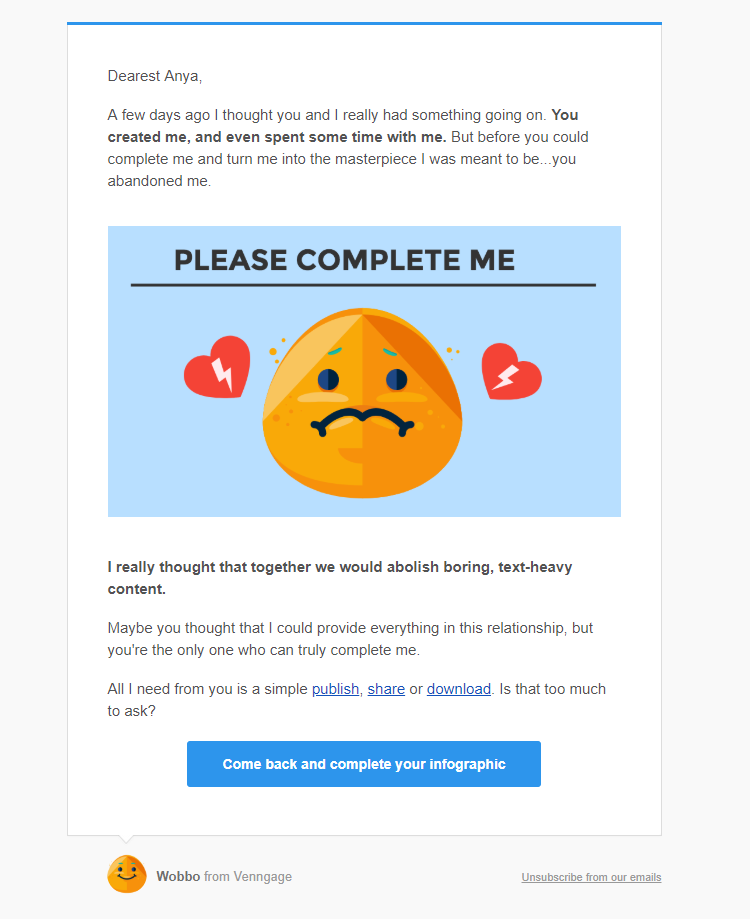
FAQ
? Can I send follow-up emails with SendPulse?
Yes. Register with SendPulse, and set up a trigger event for a purchase, or abandoned shopping cart, for instance. After that, create an automated flow with a follow-up email template.
? What is the purpose of sending follow-up emails?
Follow-up emails help re-engage users when they quit some key conversational touchpoints. For example, it’s when a user starts to fill in your event registration form and abandons it, or leaves the purchasing process before the transaction is over. In such cases, it’s essential to send follow-up emails to increase the number of conversions.
? How much does it cost to send an automated follow-up email?
Register with SendPulse, and send up to 15,000 automated emails to 500 recipients monthly at no cost. You can also create up to 5 events for free with SendPulse.
Last Updated: 26.09.2024


![How to Write A Successful Renewal Email [Examples Included]](https://www.spcdn.org/blog/wp-content/uploads/2020/12/renewal-email-cover-1.png)


or